By now you know the rap, that members of the Letterboxd community were doing a month-long challenge to watch thirty of the movies in Roger Ebert’s list of Great Movies, and a viewing of Beyond the Valley of the Dolls to boot. At least that was what I thought; returns to the site find that original Challenge page gone, and only one other list beside mine using the “EbertMay” tag.
Ah well. I watched a lot of good movies. Only two left to finish up the Challenge.
The Last Temptation of Christ (1988)
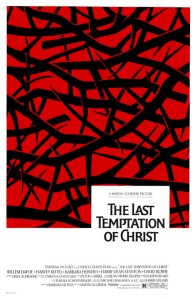 This was twenty-five years ago? Good Lord (to turn a phrase).
This was twenty-five years ago? Good Lord (to turn a phrase).
I didn’t see this at the theaters because a) I’m not a Christian, though raised as one and pretty up on the scriptures – moreso than some professed Christians, apparently; and b) I was on staff of a small regional theater at the time. That theater is doing very well for itself now, but back then we’re talking horrific schedules, day and night, grueling definitely-for-young-people stuff. I can place the movie in that period only because I leaned on Peter Gabriel’s soundtrack heavily for a particularly awesome version of Hamlet we mounted in that time.
Ha ha, you young’uns that were born at the tail-end of the 80s and in the 90s missed quite a to-do, let me tell you. Televangelism, riding so high in the late 70s and early 80s, had suffered through some pretty bad scandals, and Last Temptation proved a very convenient “Hey! Look over here!” distracting target. Protests and picket lines were numerous. Molotov cocktails were thrown inside a Paris theater showing the movie.
There was an interview with Martin Scorsese, the director, that I recall reading. It was memorable because the journalist reported the complicated phone tag, the mysterious directions to a nondescript apartment, where the door was answered by a burly, armed security guard, before he could even get into the same room as Scorsese; that’s how serious the shit had gotten. There are people who still refuse to watch the Academy Award nominee Hugo because Scorsese directed Last Temptation a quarter of a century ago.
None of these people ever bothered to watch this movie, either. Of course.
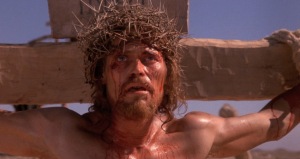 The reason for this rancor is two-fold: the first is right there in the title. On the cross, a young girl appears to Christ (played by Willem Dafoe), who introduces herself as his guardian angel. She reveals the crucifixion was a test, like the time God ordered Abraham to sacrifice his son, and just like then, the test has been passed. There is no reason for Jesus to die, and he finds himself free of the cross and nails. He marries Mary Magdalene, has sex with her – this is where the line got drawn – and when she dies, he takes up with Martha and Mary (the sisters of Lazarus) and sires several children, living as a normal man. This has ramifications, resulting in the ultimate sacking of Jerusalem and Jesus’ discovery that the girl is actually Satan, using a far more sophisticated pitch than he employed when Jesus was fasting in the desert. Jesus denies this last temptation, and finds himself on the cross again, saying, “It is accomplished.”
The reason for this rancor is two-fold: the first is right there in the title. On the cross, a young girl appears to Christ (played by Willem Dafoe), who introduces herself as his guardian angel. She reveals the crucifixion was a test, like the time God ordered Abraham to sacrifice his son, and just like then, the test has been passed. There is no reason for Jesus to die, and he finds himself free of the cross and nails. He marries Mary Magdalene, has sex with her – this is where the line got drawn – and when she dies, he takes up with Martha and Mary (the sisters of Lazarus) and sires several children, living as a normal man. This has ramifications, resulting in the ultimate sacking of Jerusalem and Jesus’ discovery that the girl is actually Satan, using a far more sophisticated pitch than he employed when Jesus was fasting in the desert. Jesus denies this last temptation, and finds himself on the cross again, saying, “It is accomplished.”
But never mind that, they showed Jesus getting it on.
The second blow Against All That Is Decent is presenting Jesus as a conflicted man instead of the confident avatar of all that is good and decent, as presented in Vacation Bible Schools.
There is a valid school of theological thought that notes the concept of God evolves as civilization develops; thus we go from a God who heartily endorses wiping out entire tribes to the rather radical concept of the same God preaching love. One scholar goes so far as to posit God pouring a part of Himself into a mortal vessel, to suffer as his creation does, as a sort of apology to those creations, with that apology ultimately taking the form of a slow, agonizing death. Suicide as an act of contrition.
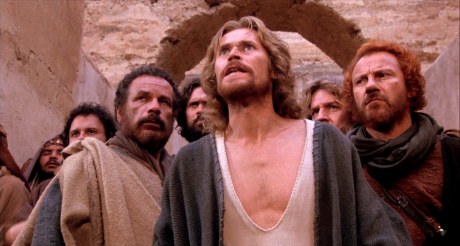 The political angle is probably another thorn in the side of fundamentalists (though heaven forfend they should abandon their political activities). An eye-opening book for me (come to think of it, read at about this time) was Michael Baigent’s The Messianic Legacy, which examined Jesus and the disciples in their roles as political activists. Viewing Last Temptation has left me with the desire for a re-read. As Pontius Pilate (David Bowie) says to Jesus after he denies being King of the Jews or any special divinity, “That just makes you another Jewish politician.” Politics is an unfortunate, constant fact of life, even of civilization. How could a Messiah avoid them, especially if one of the roles of the Messiah is to deliver his people from oppression, either secular or spiritual?
The political angle is probably another thorn in the side of fundamentalists (though heaven forfend they should abandon their political activities). An eye-opening book for me (come to think of it, read at about this time) was Michael Baigent’s The Messianic Legacy, which examined Jesus and the disciples in their roles as political activists. Viewing Last Temptation has left me with the desire for a re-read. As Pontius Pilate (David Bowie) says to Jesus after he denies being King of the Jews or any special divinity, “That just makes you another Jewish politician.” Politics is an unfortunate, constant fact of life, even of civilization. How could a Messiah avoid them, especially if one of the roles of the Messiah is to deliver his people from oppression, either secular or spiritual?
We won’t even address the subject of Judas, here removed from the role of Designated Villain to Disciple With The Toughest Job, possibly the most faithful disciple of all. That is the sound of heads exploding in the distance.
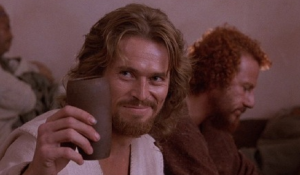 So it turns out The Last Temptation of Christ was the Jesus movie I had wanted all my life: it does not ignore the “Son of Man” part of the story, though I can’t say it glories in it, either. Jesus is confused, conflicted, unsure, fearful – all the things a contrite Deity should feel, as He experiences what his creation must deal with on a daily basis. If the Scriptures are to be believed, Jesus was at least half human, and that is the half that most doctrine studiously ignores. You hardly ever hear about the Cursing of the Fig Tree, for instance, which was a pretty human moment, no matter how many attempts to turn it into an example of the power of prayer.
So it turns out The Last Temptation of Christ was the Jesus movie I had wanted all my life: it does not ignore the “Son of Man” part of the story, though I can’t say it glories in it, either. Jesus is confused, conflicted, unsure, fearful – all the things a contrite Deity should feel, as He experiences what his creation must deal with on a daily basis. If the Scriptures are to be believed, Jesus was at least half human, and that is the half that most doctrine studiously ignores. You hardly ever hear about the Cursing of the Fig Tree, for instance, which was a pretty human moment, no matter how many attempts to turn it into an example of the power of prayer.
So did it convert me? No. But then I don’t really believe that was the purpose behind it. Scorcese said he had always wanted to make a Jesus movie, and when the original production was cancelled by Paramount, he persevered. Universal finally green-lighted it, with a truncated shooting schedule and a budget fully half of what Paramount had agreed to – and at that, Scorsese had to agree to make a “Commercial” movie in exchange (Universal got Cape Fear out of the deal, so it was pretty good investment, overall). This was a passion production (you should forgive the double meaning) for Scorsese and many of the personnel (like Barbara Hershey, who had given Scorsese a copy of the book back during Boxcar Bertha), and it shows.
So the angry True Believers can keep themselves warm with their protest signs and their molotov cocktails. I’ve got my Jesus, and I am perfectly okay with him.
The Bride of Frankenstein (1935)
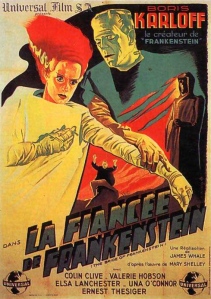 So a little more tampering in God’s domain. I definitely took it easy on myself for the last movie in the Challenge, finally pulling out that Universal Monsters Blu-Ray set again.
So a little more tampering in God’s domain. I definitely took it easy on myself for the last movie in the Challenge, finally pulling out that Universal Monsters Blu-Ray set again.
After the incredibly successful Frankenstein, director James Whale spent the next four years scrupulously refusing to do a sequel, until he was promised artistic freedom. The result is one of the best horror films ever made.
After an odd little vignette that has Mary Shelley (Elsa Lanchester) telling Byron that the end of her novel was not the end of the story (and also has Byron referring to the Monster itself as Frankenstein, Universal Pictures buying into and perpetuating that little bit of cultural mangling), Bride literally begins at the end of the first movie, the burning of the windmill with the Monster inside. Much as Baron Frankenstein survives, so does the Monster, falling through the burning floor into a flooded chamber.
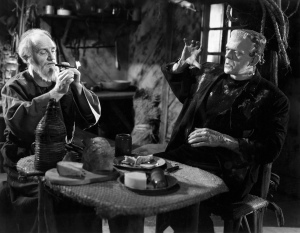 So the Monster roams the countryside, and he’s more than a little put-off with his treatment, made worse when he rescues a shepherdess from drowning and, naturally, it is assumed he’s attacking her. It’s perfectly obvious that Whale’s sympathies lie with the misunderstood monster, and it’s never more clear than the famous scene where the Monster finds the blind hermit, drawn by the smells of food and beguiled by the music of his violin. This sequence is genuinely touching, both the hermit and the Monster reduced to tears of gratitude for deliverance from their loneliness.
So the Monster roams the countryside, and he’s more than a little put-off with his treatment, made worse when he rescues a shepherdess from drowning and, naturally, it is assumed he’s attacking her. It’s perfectly obvious that Whale’s sympathies lie with the misunderstood monster, and it’s never more clear than the famous scene where the Monster finds the blind hermit, drawn by the smells of food and beguiled by the music of his violin. This sequence is genuinely touching, both the hermit and the Monster reduced to tears of gratitude for deliverance from their loneliness.
Concurrent to that, Victor Frankenstein has renounced tempering in God’s domain and is trying to finally get married and leave Gothicland, when he is visited by one of his old teachers, Dr. Septimus Praetorius (a silky smooth and utterly charming Ernest Thesinger), who has been conducting his own experiments in life creation: a series of homunculi living in jars. He wants Frankenstein’s aid in creating something more substantial, an actual, life-sized human being. The younger scientist, having recently survived one such creation, refuses.
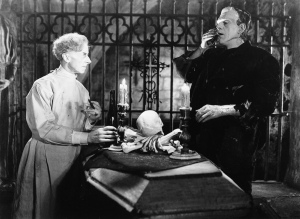 The Monster, never having a surplus of luck, gets rousted from the hermit’s cabin (by an interfering John Carradine, no less), gets captured, escapes (killing several villagers, whom everybody’s getting sick of, anyway) and takes refuge in a huge mausoleum, where he is discovered by a grave-robbing Praetorius. Realizing that he has found a perfect lever to move the intractable Frankenstein, Praetorius promises the Monster that he will make a friend for him – a woman, to be his bride.
The Monster, never having a surplus of luck, gets rousted from the hermit’s cabin (by an interfering John Carradine, no less), gets captured, escapes (killing several villagers, whom everybody’s getting sick of, anyway) and takes refuge in a huge mausoleum, where he is discovered by a grave-robbing Praetorius. Realizing that he has found a perfect lever to move the intractable Frankenstein, Praetorius promises the Monster that he will make a friend for him – a woman, to be his bride.
Bride is the very rare sequel that betters its predecessor, by not only giving the audience more of the same, but also expanding intelligently on the themes of the first. Karloff himself felt that the hermit teaching the Monster to speak was a mistake, and to be sure, all the power of the original movie derives from his astonishing, mute performance. But as the Monster becomes more adult, as it were,speaking in simple sentences and continually brutalized by a world uninterested in understanding his plight, we are also watching his corruption; manipulated by Praetorius, he finally becomes the villain the world expected, though at the end, consumed by sorrow and despair, he does try to set things right by the only means he knows, or has been allowed to learn: by destruction.
 Mention must definitely be made of the Bride, also played by Elsa Lanchester. A striking figure, moving like a clockwork robot, due to Pretorius’ artificial brain, the five foot Lanchester stands on stilts concealed beneath her flowing robes to bring her to seven feet. As archly pointed out in Gods and Monsters, not only have the mad scientists dressed her, but they’ve done her hair, now cascading upwards over a wire mesh foundation. Lanchester modeled her performance, the startled hissing at the Monster’s appearance, on wild swans. For all its brevity, it is one of the most unique, memorable performances of the universal Classic Monster series.
Mention must definitely be made of the Bride, also played by Elsa Lanchester. A striking figure, moving like a clockwork robot, due to Pretorius’ artificial brain, the five foot Lanchester stands on stilts concealed beneath her flowing robes to bring her to seven feet. As archly pointed out in Gods and Monsters, not only have the mad scientists dressed her, but they’ve done her hair, now cascading upwards over a wire mesh foundation. Lanchester modeled her performance, the startled hissing at the Monster’s appearance, on wild swans. For all its brevity, it is one of the most unique, memorable performances of the universal Classic Monster series.
The Bride is also the only Classic Monster to achieve her fame without killing anybody. Not that she ever really had the chance…


